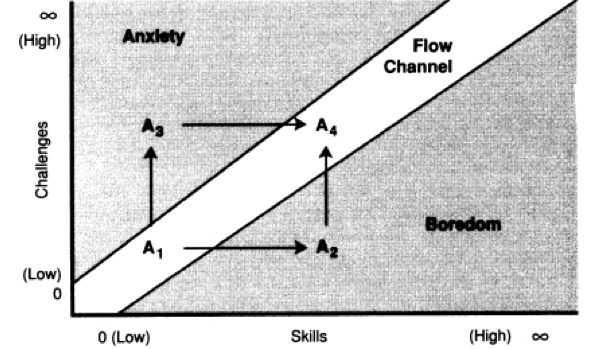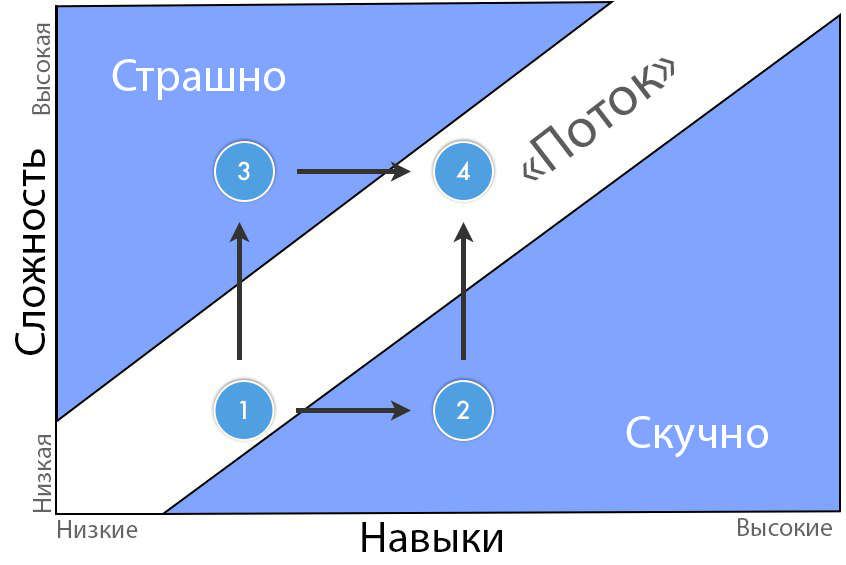How to enter the "stream": a magical scheme that will suit everyone
- Transfer

A stream is a magical place in which you are completely absorbed in what you are doing, where time passes so fast that it seems as if it does not exist at all . Of course, such a behavior model will not suit everyone, but to someone it seems quite acceptable! Reflections by Chris Bailey (Chris Bailey) on how to get to this place without radical changes in his own life.
I recently finished reading the book “Flow” ( ★ ) Mihaly Csikszentmihalyi (Mihai Chiksentmihayli); this is a rather boring and dry book, but it contains several brilliant things. These include, for example, the scheme published in the book. But I decided to improve it a little.

Let's add some color, tweak the lines, make the design prettier ...

Well, much better.
If you do not have the slightest idea of what this scheme is, it's okay. Here is a brief summary of what is shown on it:
- Any type of activity that you do can find a place in this scheme (depending on how complicated it is (for you) and how many of your skills it involves).
- The ideal place for him, you guessed it, in the "stream". In it, the complexity of your task ideally matches your skills. Especially if you have the motivation to do something . As Mihai Chiksentmihayi says, in this stream you will be very happy. For example, writing “Csikszentmihalyi” is a rather difficult task, but it will not require a lot of skills, which transfers this type of activity to the “Anxiety” corner.
In The Stream, Mihai uses tennis training to illustrate how we enter the state of flow. I added four circles to my circuit to parse this example.

“1” is your starting position. Here you play tennis for the first time. Learn to serve the ball (which is difficult, but doable for the first time) and try to get to the other part of the court from your place (or something like that - I admit, I do not understand tennis at all). In this segment, you are experiencing a streaming state, because your task is equal to your skills, and you have fun.
Then one of two things can happen.
You are moving to "2". You improve your skills until it becomes boring just to throw the ball over the net. The task of the game is now below the level of your skills, and you are no longer in the stream.
You go to "3" . And set yourself a task that makes you strain - for example, you decide to play tennis with a friend-athlete, and he “made you”. Here the task is higher - that is, more difficult than the level of your skills, and you no longer experience the sensation of flow.
Depending on where you are, there are two ways to return to the streaming channel.
If you are bored ( “2” ), you will need to find a more difficult task, for example, find a partner to play with skills equal to yours.
If you are concerned ( “3” ), you will needimprove your tennis skills in order to return to the flow (you can also reduce the complexity of the task, but this is not so easy to do in practice).
Mihai says it
“Explains how the streaming state leads to growth and discovery. A person cannot like to do the same thing, staying at the same level for a long time. We either get bored, or we get upset; then the desire to enjoy something pushes us to improve skills or open up new possibilities for using existing ones. ”
Any type of activity that you do is somewhere on this diagram, and according to the research of Chiksentmihayli, it is precisely those types of activity that can enter into a streaming state, will make you happiest of all.
Then you will either have to improve your skills or change tasks, adapting them to yourself in order to survive the streaming state more often.
PS We recommend another article on the topic - 21 tips that allow you to turn into the most productive person .
The author of the translation is Vyacheslav Davidenko, founder of MBA Consult .
